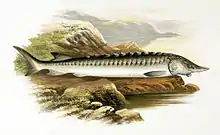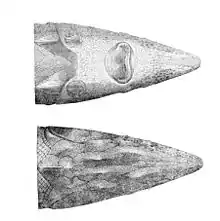European sea sturgeon
The European sea sturgeon (Acipenser sturio), also known as the Atlantic sturgeon or common sturgeon, is a species of sturgeon native to Europe. It was formerly abundant, being found in coastal habitats all over Europe. It is anadromous and breeds in rivers. It is currently a critically endangered species.[1] Although the name Baltic sturgeon sometimes has been used, it has now been established that sturgeon of the Baltic region are A. oxyrinchus, a species otherwise restricted to the Atlantic coast of North America.[5]
| European sturgeon | |
|---|---|
 | |
| Acipenser sturio | |
| Scientific classification | |
| Domain: | Eukaryota |
| Kingdom: | Animalia |
| Phylum: | Chordata |
| Class: | Actinopterygii |
| Order: | Acipenseriformes |
| Family: | Acipenseridae |
| Genus: | Acipenser |
| Species: | A. sturio |
| Binomial name | |
| Acipenser sturio | |
| Synonyms[3][4] | |
|
List
| |
Description


The wedge-shaped head of the European sea sturgeon ends in a long point. There are many sensitive barbels on the facial area. The dorsal fins are located very far back on the body. Five longitudinal lines of large osseous plates are found on the body of the fish. The stomach is yellow and the back is a brownish grey.
This sturgeon can reach 6 m (20 ft) and 400 kg (880 lb) in weight, but a more common length is 1.25 m (4 ft 1 in).They can reach an age of 100 years, and have a late sexual maturity (12 to 14 years for the males and 16 to 18 years for the females).
Distribution and habitat
They are found on the coasts of Europe, except in the northernmost regions and the Baltic region, and have rarely even been known to cross the Atlantic Ocean to the coasts of North America. Like many other sturgeons, they spawn in the rivers inland from the coast. The species can tolerate wide spread salinities and spend most of their lives in saltwater but migrate to spawn in freshwater.
Conservation
Until the first decades of the twentieth century, these fish were locally abundant in Europe and were caught extensively for their caviar, but a sharp decline due to overfishing (which greatly accelerated from the second half of the nineteenth century onwards) led to their disappearance from the vast majority of their former range. They have been a protected species in Europe since 1982. Despite their estimated range of distribution, they have become so rare that they only breed in the Garonne river basin in France.[6] Conservation projects involving this species include reintroductions based on specimens from aquaculture with the first releases in 1995.[1] For example, 87 sturgeons were experimentally released in the Rhine near Nijmegen in 2012 and 2015.[7]
Diet
Like other sturgeons, they eat polychaete worms and crustaceans which they find with their barbels.[8]
Threats
Historical habitat changes to the European sturgeon, such as gravel extraction from riverbeds and damming of the Dordogne and Garonne Rivers, have resulted in a reduction in the number of available spawning sites, contributing to the species' low abundance and regional dispersion. Furthermore, despite recent gains in compliance with fisheries bans, bycatch in commercial benthic trawls and gillnet fisheries threatens reintroduction attempts and is regarded the biggest threat to the remaining population and a major impediment to the species' recovery.
Population
Although no specific population estimates are available, the abundance of wild, mature European Sturgeon is estimated to be less than 800 individuals. The last time the species hatched was in the Garonne River in France in 1994, and genetic analysis reveals that the 1994 cohort was formed by only one mating pair. Because the wild population is so small, a captive breeding and stocking program is vital to the species' survival. Although restoration operations, such as artificially bred individual restocking, have been successful in the Gironde estuary and the Elbe River (Germany), recovery for the European sturgeon is a long process that might take 30-50 years. Bycatch in commercial trawls and gillnets, pollution, climate change, and potential competition with other species are dangers to the species.
Scientific classification
| Kingdom | Animalia |
|---|---|
| Phylum | Chordata |
| Class | Actinopterygii |
| Order | Acipenseriformes |
| Family | Acipenseridae |
| Genus | Acipenser |
| Species | sturio |
References
- Gessner, J.; Williot, P.; Rochard, E.; Freyhof, J. & Kottelat, M. (2022). "Acipenser sturio". IUCN Red List of Threatened Species. 2022: e.T230A137215851. doi:10.2305/IUCN.UK.2022-1.RLTS.T230A137215851.en. Retrieved 21 March 2023.
- "Appendices | CITES". cites.org. Retrieved 2022-01-14.
- Froese, R.; Pauly, D. (2017). "Acipenseridae". FishBase version (02/2017). Retrieved 18 May 2017.
- "Acipenseridae" (PDF). Deeplyfish- fishes of the world. Retrieved 18 May 2017.
- Ludwig, A; Arndt, U; Lippold, S; Benecke, N; Debus, L; King, T. L.; Matsumura, S (2008). "Tracing the first steps of American sturgeon pioneers in Europe". BMC Evolutionary Biology. 8: 221. doi:10.1186/1471-2148-8-221. PMC 2527320. PMID 18664258.
- "Protection of common sturgeon: advice for fishermen". gov.uk. January 16, 2017.
- Brevé, N. W., Vis, H., Houben, B., Breukelaar, A., & Acolas, M. L. (2019). Outmigration pathways of stocked juvenile European sturgeon (Acipenser sturio L., 1758) in the Lower Rhine River, as revealed by telemetry. Journal of Applied Ichthyology, 35(1), 61-68.
- Brosse, L., Taverny, C., & Lepage, M. (2011). Habitat, movements and feeding of juvenile European sturgeon (Acipenser sturio) in Gironde Estuary. In Biology and Conservation of the European SturgeonAcipenser sturioL. 1758 (pp. 153-163). Springer, Berlin, Heidelberg.
- "Acipenser sturio". Integrated Taxonomic Information System. Retrieved 11 March 2006.
- Burnie, David, ed. (2001), "European sturgeon", Animal, Dorling Kindersly, p. 481

.jpg.webp)